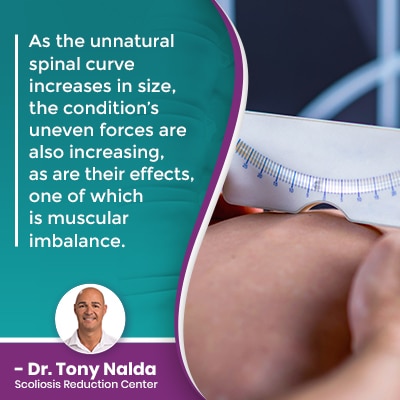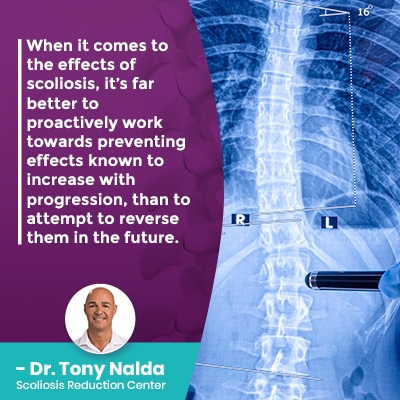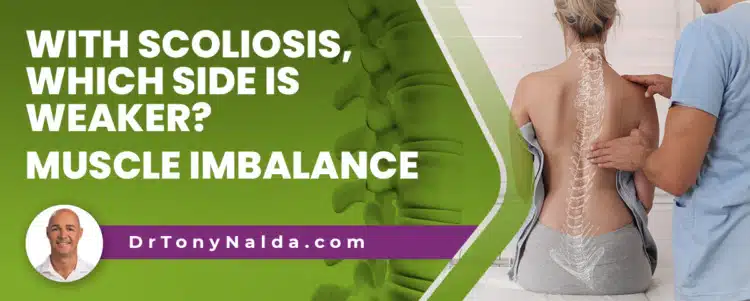Scoliosis can affect the body in a number of ways. When an unnatural sideways spinal curve develops, it can lead to a number of imbalances, including posture and the muscles that surround the spine. A common effect is that the muscles on one side of the spine become weak, while the opposite side’s muscles are strong from overuse; however, both issues are problematic.
Scoliosis introduces uneven forces to the body that can cause a number of effects. From a disruption to the body’s overall symmetry to muscle imbalance, as scoliosis develops, it makes the muscles on one side of the spine weak from lack of use, and the opposite side strained from overuse.
Let’s start our look at scoliosis-related muscular imbalance by first touching on what’s happening inside the body of someone recently diagnosed.
Being Diagnosed with Scoliosis
Scoliosis is a spinal condition that deserves some awareness; it’s highly-prevalent, with current estimates at close to seven million people living with it in the United States alone.
It is the leading spinal condition amongst school-aged children, and while there are never treatment guarantees, early detection and intervention, with proactive treatment, does increase chances of treatment success.
Scoliosis is a condition of asymmetry as it involves the development of an unnatural lateral (sideways) spinal curve that doesn’t just bend unnaturally to the side, but also twists: rotational component.
The spine performs many important functions including allowing us to stand upright, practice good posture, protecting organs, and working with the brain to form the body’s vast communication network: the central nervous system (CNS).
If the spine loses one or more of its healthy curves, it responds by putting in bad curves, which disrupts a number of things.
The spine’s overall strength, function, and biomechanics are disrupted, along with the body’s overall symmetry, particularly in severe forms, and especially when left untreated, or not treated proactively.
Being diagnosed with scoliosis also means living with a progressive condition whose nature is to worsen over time.

As the unnatural spinal curve increases in size, the condition’s uneven forces are also increasing, as are their effects, one of which is muscular imbalance.
The muscles that help support the spine are the large muscles of the lower back, known as the erector spinae, and these hold up the spine, along with the gluteal muscles.
Flexor muscles are attached to the spine at the front, and these muscles, along with the core abdominal muscles, facilitate a wide range of flexible movements: bending, lifting, and arching of the lower back.
Scoliosis: Which Side is Weaker?
The spine has three main sections: cervical spine (neck), thoracic spine (middle/upper back), and the lumbar spine (lower back).
As the thoracic spine is the largest spinal section, it makes sense that it is also the most common area to develop scoliosis, but it can develop in any spinal section.
Each section has its own characteristic, natural, and healthy curvature type, and while these curves have a healthy range in size, if a person’s curvature degree falls beyond a normal range, problems can occur related to a disruption to the spine’s biomechanics.
And it’s not just the spine that’s in charge of maintaining its natural curves and alignment, but also its surrounding muscles that have to work hard to provide it with adequate support and stabilization.
Now, scoliotic curves can bend to the left, towards the heart, but this is considered atypical and related to an underlying pathology; typical scoliotic curves bend to the right, away from the heart.
So let’s look at a typical case of moderate adolescent idiopathic scoliosis, which is the condition’s most-prevalent condition type, with the curve bending to the right.
In these types of cases, the spine bending to the right means the muscles on the right side of the spine are working harder, getting stretched and becoming overused, while the muscles on the left side of the spine are becoming smaller and weaker from lack of use: creating a muscle imbalance.
Now, as a progressive condition, one of the benefits of starting treatment early is that the body has had less time to adjust to the unnatural spinal curve’s presence, which means the spine’s surrounding muscles might not have developed severe imbalances yet.

When it comes to the effects of scoliosis, it’s far better to proactively work towards preventing effects known to increase with progression, than to attempt to reverse them in the future.
So when it comes to which side of the body is weaker and tighter, it will depend on the direction of the curve; for typical curves bending to the right, the right side will be stronger, while the left side becomes tight and weak.
For atypical curves that bend to the left, the muscles on the left side of the body are going to be stronger from overuse, while the muscles to the right of the spine can become smaller and weaker from lack of use.
What are the Effects of a Scoliosis Muscle Imbalance?
The term muscle atrophy is referring to a muscle that has decreased in size and is experiencing a wasting of muscle tissue caused by lack of use.
As muscles begin to atrophy, they are on the road to wasting away; you’ve likely heard the expression, “If you don’t use it, you lose it,” and this can definitely be applied to muscle strength in the aging population and/or when a condition is present capable of causing a muscle imbalance, like scoliosis.
So what are the effects of living with a scoliosis-related muscle imbalance?
Scoliosis patients experiencing muscle imbalance are likely to find it uncomfortable and painful, and these effects can be particularly disruptive for athletes and/or those who regularly participate in sports and demanding physical activities.
The lack of strength and mobility that results from a muscle imbalance can impact a person’s ability to keep up with their daily tasks and responsibilities, not to mention impacting overall quality of life.
Now that we’ve explored how scoliosis can cause a muscle imbalance, the next important question is what can be done about it?
How to Fix Muscle Imbalance Scoliosis
When it comes to fixing a muscle imbalance caused by scoliosis, the answer is the same regarding any of the condition’s adverse effects: proactive treatment.
Remember, scoliosis is progressive, and its progressive line is from mild to moderate and severe to very severe, which are also the condition’s severity levels, and a patient’s severity level is a key factor when it comes to designing customized and effective treatment plans.
Here at the Scoliosis Reduction Center®, I apply a conservative chiropractic-centered treatment approach that values starting treatment as close to the time of diagnosis as possible.
While there are no treatment guarantees, starting treatment before significant progression has already occurred means the spine’s rigidity hasn’t yet increased significantly and the muscles are less affected.
Through condition-specific chiropractic care, I work towards addressing areas of vertebral subluxation by manually adjusting them back into alignment with the rest of the spine; as scoliosis is a structural condition, this means impacting it structurally addresses the underlying cause of symptoms, such as postural deviation, pain, and muscle imbalances.
Once I start to see a curvature reduction on a structural level, I shift the treatment focus to increasing core strength so the spine is optimally supported by its surrounding muscles, and this is done through condition-specific physical therapy and a series of scoliosis-specific exercises (SSEs) that can also address muscle imbalance by strengthening weak muscles and relying less on overused muscles.
So the best way to address a muscle imbalance caused by scoliosis is to impact its underlying cause: the condition itself.
Treating scoliosis proactively also means working towards minimizing the condition’s effects by preventing progression and increasing symptoms, one of which is muscle imbalance.
Conclusion
When an unnatural spinal curve is developing, uneven forces are being introduced to the body, which can have a number of effects.
It’s not just the spine that maintains its natural curves and alignment, but also its surrounding muscles, and if an unhealthy spinal curve is present, those muscles are struggling to support the unnaturally-curved spine.
Supporting a scoliotic spine means the muscles on the side the spine is bending towards, in most cases, the right, are becoming overused and stretched, while the muscles on the opposite side of the spine are becoming weak from underuse, and this can lead to muscle atrophy.
In order to minimize the effects and symptoms of scoliosis, the condition has to be treated proactively, and this means, first and foremost, impacting it on a structural level with a curvature reduction.
By reducing the size of the unnatural spinal curve, the underlying cause of the condition’s effects and symptoms is being addressed, and this is the only way to achieve long-term sustainable treatment results.




